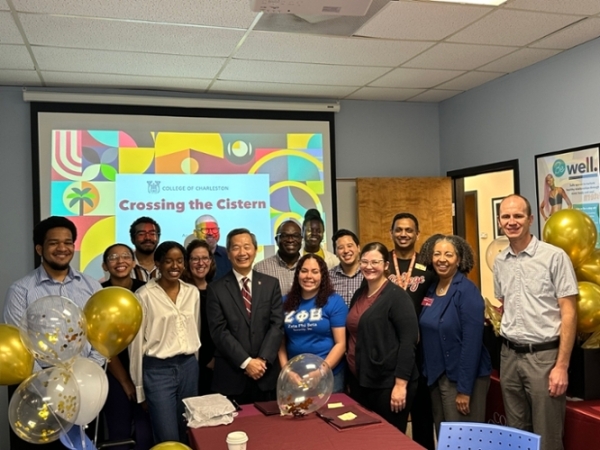You have /5 articles left.
Sign up for a free account or log in.

The College of Charleston has hosted its commencement ceremonies for decades at the Cistern, pictured here in 2018. The institution’s “Crossing the Cistern” program encourages underperforming students to stay engaged and persist to graduation.
Jeff Greenberg / Contributor / Universal Images Group Editorial
One of the most common barriers to student engagement and success is students’ conflicting priorities. A 2023 Student Voice survey by Inside Higher Ed, conducted by College Pulse, found 41 percent of students say they do not participate in campus events because of the timing or location of events and a third of students are limited by their off-campus work obligations.
College of Charleston leaders recognized the role of student supports in benefiting student development, not just in teaching academic skills but in creating a sense of belonging and connection to the institution.
A seven-year-old program at the college, “Crossing the Cistern,” benefits a cohort of students each year with mentorship, scholarship funds and development activities that promote professionalism, achievement and thriving in higher education.
The background: Crossing the Cistern launched in 2017 to provide financial support, encouragement, academic support, mentoring, internships and volunteer experiences to around a dozen sophomores and juniors who held a 2.0 to 2.5 GPA.
“We call it a momentum program, really designed to engage and support students who are, maybe they’re losing touch with the college, maybe their grades aren’t where they need to be,” says Courtney Howard, chief diversity officer and vice president for diversity, equity and inclusion.
The name, Crossing the Cistern, comes from the college’s tradition of hosting commencement at the on-campus cistern, making the allusion of helping students overcome challenges and attain their degrees.
CTC is different from an academic probation program because students aren’t considered at-risk, Howard says, they’re just not reaching their full potential. The program is like a hug from the institution, helping to get them back on track.
Following the program’s initial success, university leaders decided to expand the initiative into the college’s six academic schools in 2021. Now, each college has at least one coordinator who runs the program, expanding the reach of the initiative to 50 to 70 students across the institution.

Each spring, program leaders celebrate current and past Crossing the Cistern participants on their graduation. Graduates can also wear a special cord at graduation to signify their participation.
College of Charleston
How it works: The office of diversity, equity and inclusion serves as the central hub for each of the colleges, providing scholarship funding, stipends for coordinators and general programming.
Program intake varies by each school. Sometimes students are recruited by a faculty or staff member, other times they apply, some directly inquire about the program because they’ve heard of it through word of mouth, Howard says.
Students are eligible to join in their sophomore, junior or senior year, with the option to renew annually through their final year at the college. Scholarships range up to $650 for the academic year.
Once in the program, students are provided academic advising, one-on-one and group mentoring from faculty and staff, scholarships, extracurricular programming and peer communities. In some schools, students are paired with a faculty member who serves as a mentor as well.
What’s different: While finances are a common barrier to persistence for at-risk students, scholarship funding isn’t the primary focus of the program, and that’s a direct result of feedback from students.
“In talking to those students, it was determined that it wasn’t the scholarship money that the students wanted—and of course, everyone could use some scholarship money—but it wasn’t the thing that really kept them engaged,” Howard shares. “It was the other activities, the mentoring, the fellowship.”
Over the years, the college has increased funding for programming and engagement rather than scholarship dollars to meet that need, and the shift to a cohort model within schools helps encourage that dynamic as well.
A newer feature is experiential learning grant funding that program participants can apply for to put toward unpaid or underpaid internships, study abroad or other experiences, to develop them professionally outside of the classroom.
One of the program’s goals is also to celebrate students’ wins.
“These are not the students who are typically getting picked for all the different opportunities, these are students who are sometimes in the shadows,” Howard explains.
This past year, staff launched an initiative, “Elevating your CTC Experience,” in which students are recognized for making small gains and moving outside their comfort zones. The effort provides an incentive for high-impact practices, but also to create role models for other participants.
The program also provides graduation cords for CTC participants, another way of celebrating their improvement and growth over their college years.
The impact: To measure effectiveness, staff track changes in cohort GPA, graduation and retention rates, as well as deliver an annual student reflection survey to gain further insight into the interventions. The goal is for students to only participate in the program for one year, but some stay on for additional support.
“It’s helped them feel like they belong,” Howard says. “It’s really helped them to feel like the College of Charleston cares.”
In the pilot years (2017 to 2021), CofC helped 40 students improve their grades and progress toward graduation. In the most recent cohort, 2024, 51 students participated in the program and 17 graduated this past spring.
DIY: For another institution interested in piloting a similar initiative, Howard encourages administrators to consider the following:
- Understand student needs. Many participants are busy with other events and responsibilities, so finding flexible ways to meet with students or provide programming is important because those are things students want.;
- Get a lay of the land. In providing programming, it’s important to know what else is being offered by other campus partners to not duplicate efforts, but instead amplify existing resources already served to students on campus. “So if the career center is having a session on how to do your LinkedIn profile, we want to be able to encourage our students to attend sessions like that,” Howard says. “We don’t want to reinvent any wheels.”
- Invest in personnel. The role of the coordinator is critical to the program’s success so, “just making sure that that compensation is reflective of the level of work and effort that these faculty coordinators are putting into the work,” is key, Howard says.
If your student success program has a unique feature or twist, we’d like to know about it. Click here to submit.








